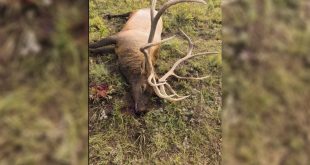When you think big bull elk, you think of the premier areas in Arizona, New Mexico, Utah and of course Nevada. If you have been a subscriber with us for long then you have probably seen the great bulls from these units that have graced our covers and interior pages over the years.
It is also no secret that a severe drought has settled in across the Southwest and if there is an enemy of antler growth this is it. Winter has finally released its chilly grip on the northern Rockies and we are seeing record book snow packs across Wyoming, parts of Idaho and Montana. This is not the case in much of the southwest where localities are already limiting water consumption due to the severity of the drought. So where does that leave hunters this year in some of the prime time elk hunting units in the affected states?
A discouraging 36% of Arizona is now in severe drought, which isn’t good for hunters who are looking to harvest a trophy bull. However, most of the blue chip units in the Members Research Section of the journals are not inside of the most stricken areas. If the summer monsoon season comes early it will provide some relief for hunters who are looking for strong antler growth. If it comes after July 15 most of the antler growth is done and the elk won’t benefit from from the rain. Trophy quality bulls will still be harvested in Arizona this fall, but to what degree remains to be seen in the midst of this severe drought.
New Mexico elk hunters will have a hard time finding a section of the state to hunt that isn’t being hammered by a lack of water. Fully 86% of the state is in a severe drought, which means weak horn growth for the majority of the state. For those of you who plan to hunt there this fall, plan on adjusting your trophy size expectations. Expectations can dictate what a hunter feels is a quality hunt, in drought years the best strategy is to lower the bar and enjoy the time in the field.
The good news for trophy hunters in Nevada is that the drought has been limited to the western half of the state, and most of what we consider to be blue chip units are in the eastern half of the state. Some portions of the eastern half of the state have managed to have snow packs above 90% of normal. This percentage means healthy antler growth in those units as well as the quality trophy potential that Nevada is known for.
For those hunting the western half the outlook is bleak and large portions of the state have been labeled “exceptional drought” or “extreme drought.” Neither descriptor is something that would instill confidence in what I would hope to find for antler quality on a bull in those units. Areas of extreme drought have numbers below 50% of normal precipitation which means hunters who burned their points in these western units shouldn’t hold out for Boone & Crocket bulls. There will still be mature bulls, but they won’t carry nearly the headgear that they would have in a normal year.
For those of you who will be lucky enough to draw a tag in California, be warned the drought there is severe. These may go down as some of the driest conditions in all of recorded weather history for the state. Enjoy the hunting you have this year, but don’t expect much relief without a drastic change in the current weather patterns.
Utah seems to be the only state in the region that isn’t suffering as long a peri of drought because the region is transitional ground from the Northern Rockies to the more arid mountains of the Southwest. However, 94% of the state is considered abnormally dry, with portions of moderate drought across the eastern half of the state. For those sitting at the top of their point pools for the blue chip units in eastern Utah the prospects should be on par with most other years.
To stay up to date with the latest prospects for future hunting and previous trends in all states across the West there is no better resource than our MRS. If you aren’t a subscriber you can sign up here.
-Guy Eastman
 Eastmans' Official Blog | Mule Deer, Antelope, Elk Hunting and Bowhunting Magazine | Eastmans' Hunting Journals
Eastmans' Official Blog | Mule Deer, Antelope, Elk Hunting and Bowhunting Magazine | Eastmans' Hunting Journals





This and all the articles that come from the fine Eastman publications is another example of how Guy and his tem keep us the hunters and readers up to date on what to expect when planning our annual hunts. A very dedicated group helping us plan our hunting adventures. Thanks Guy for your dedication to the hunting world. Dann.
Such high quality information. Another reason why Eastmans is the best in the industry. Thank you.
Just a heads up here in NM. Rain has been doing some good in SE NM. Vegetation is great, some say ” it’s the best we have seen in a long while” . In the counies of lea, Chavez, and eddy the rain has made the deer and antelope nice and healthy. Elk heards in Lincoln county are looking great mainly due to late snow that really helped the grasses get the moisture they needed.